Developing Individuals, Teams, and Organizations: A Detailed Analysis
VerifiedAdded on 2024/05/16
|28
|4572
|396
Report
AI Summary
This report provides a comprehensive analysis of developing individuals, teams, and organizations, focusing on the skills and knowledge required by HR professionals, the factors to consider when implementing learning and development, and the contribution of high-performance working to competitive advantage and employee engagement. It includes a personal development plan (PDP) to identify appropriate knowledge, skills, and behaviors, along with a personal skills audit. The report differentiates between organizational and individual learning, training, and development, emphasizing the need for continuous professional development. Furthermore, it examines how performance management, effective communication, and collaborative working support a culture of high performance and commitment within Alexandra-Reisse, a financial management firm. The analysis incorporates SWOT analysis and various performance management approaches to enhance organizational effectiveness. Desklib provides this student-contributed document along with a wealth of study resources.
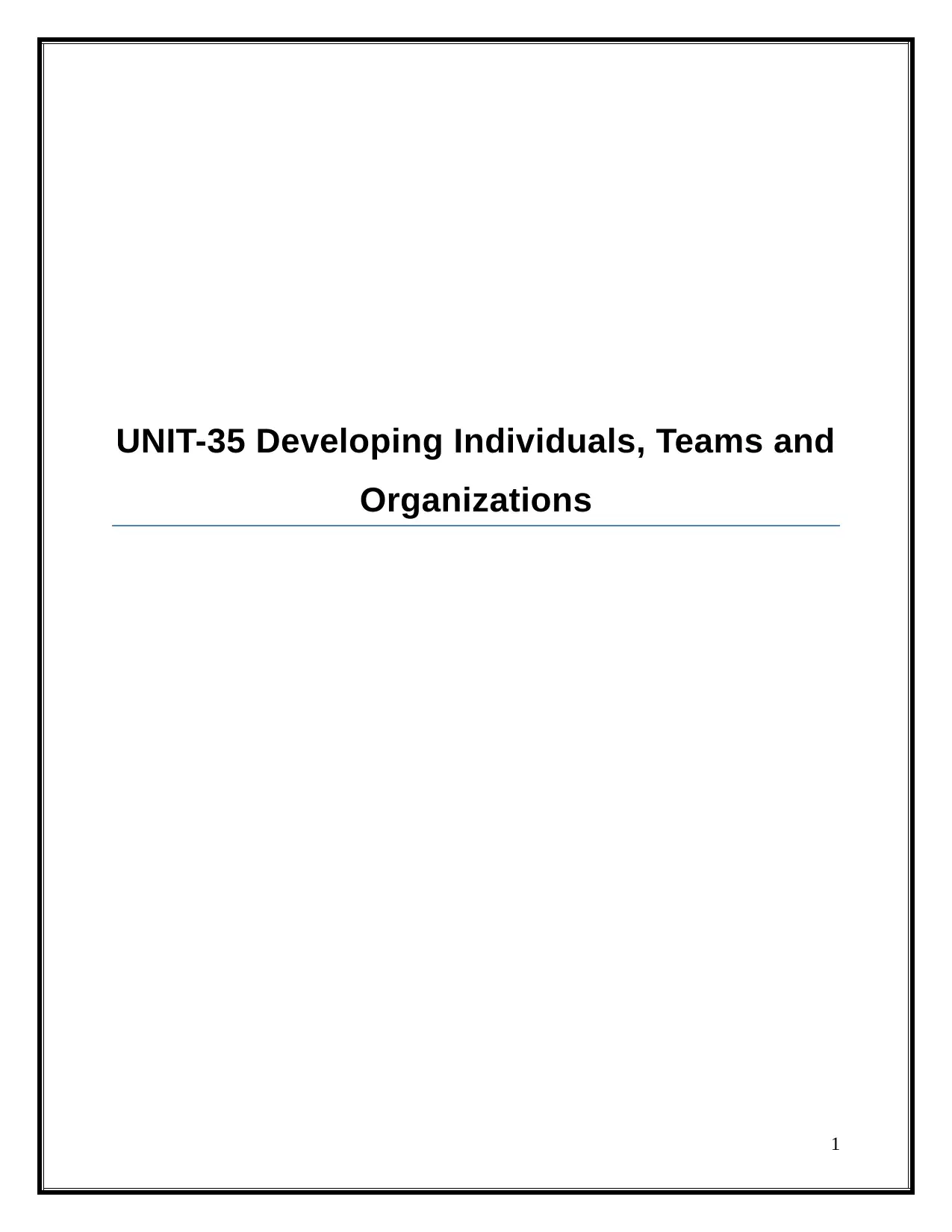
UNIT-35 Developing Individuals, Teams and
Organizations
1
Organizations
1
Paraphrase This Document
Need a fresh take? Get an instant paraphrase of this document with our AI Paraphraser
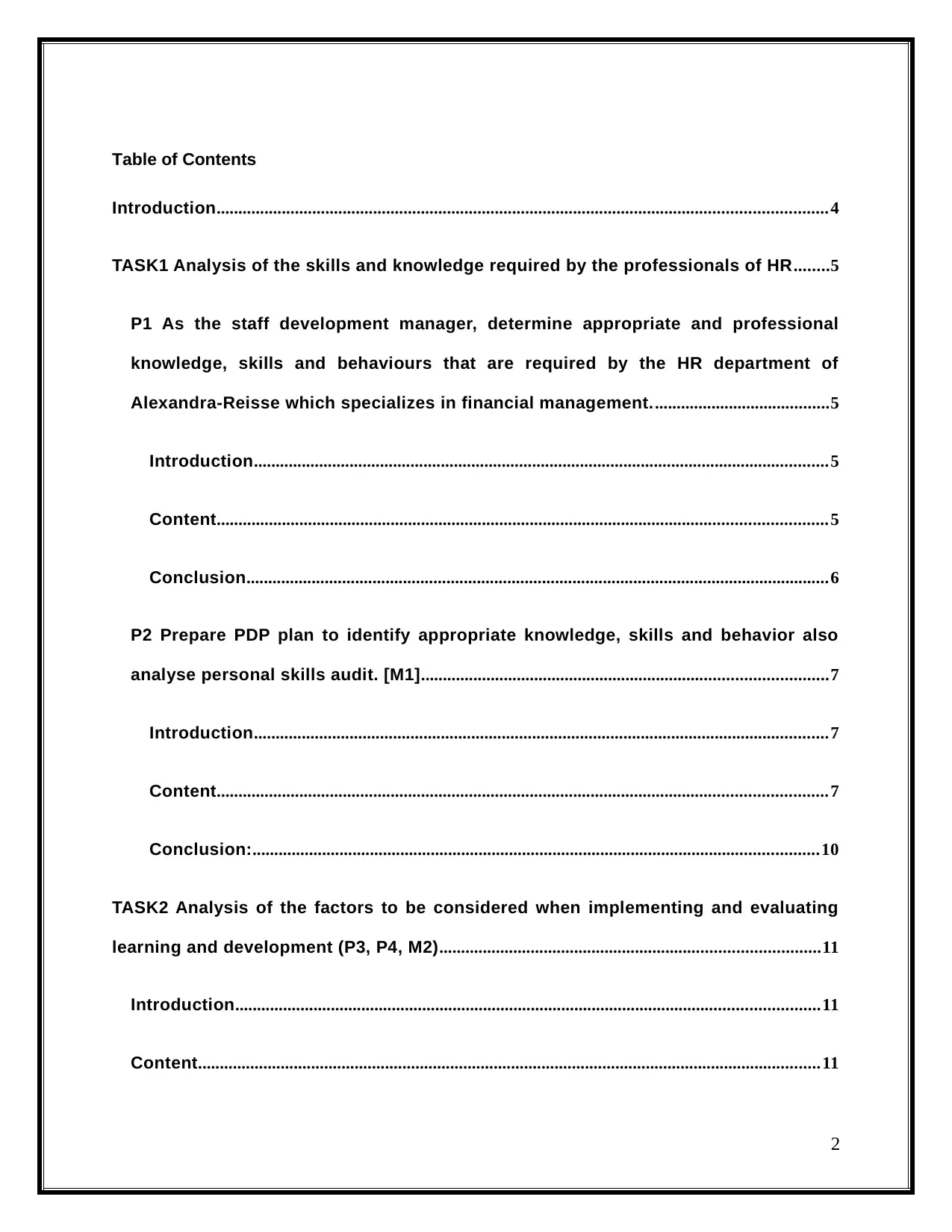
Table of Contents
Introduction............................................................................................................................................4
TASK1 Analysis of the skills and knowledge required by the professionals of HR........5
P1 As the staff development manager, determine appropriate and professional
knowledge, skills and behaviours that are required by the HR department of
Alexandra-Reisse which specializes in financial management.........................................5
Introduction....................................................................................................................................5
Content............................................................................................................................................5
Conclusion......................................................................................................................................6
P2 Prepare PDP plan to identify appropriate knowledge, skills and behavior also
analyse personal skills audit. [M1].............................................................................................7
Introduction....................................................................................................................................7
Content............................................................................................................................................7
Conclusion:..................................................................................................................................10
TASK2 Analysis of the factors to be considered when implementing and evaluating
learning and development (P3, P4, M2).......................................................................................11
Introduction......................................................................................................................................11
Content...............................................................................................................................................11
2
Introduction............................................................................................................................................4
TASK1 Analysis of the skills and knowledge required by the professionals of HR........5
P1 As the staff development manager, determine appropriate and professional
knowledge, skills and behaviours that are required by the HR department of
Alexandra-Reisse which specializes in financial management.........................................5
Introduction....................................................................................................................................5
Content............................................................................................................................................5
Conclusion......................................................................................................................................6
P2 Prepare PDP plan to identify appropriate knowledge, skills and behavior also
analyse personal skills audit. [M1].............................................................................................7
Introduction....................................................................................................................................7
Content............................................................................................................................................7
Conclusion:..................................................................................................................................10
TASK2 Analysis of the factors to be considered when implementing and evaluating
learning and development (P3, P4, M2).......................................................................................11
Introduction......................................................................................................................................11
Content...............................................................................................................................................11
2
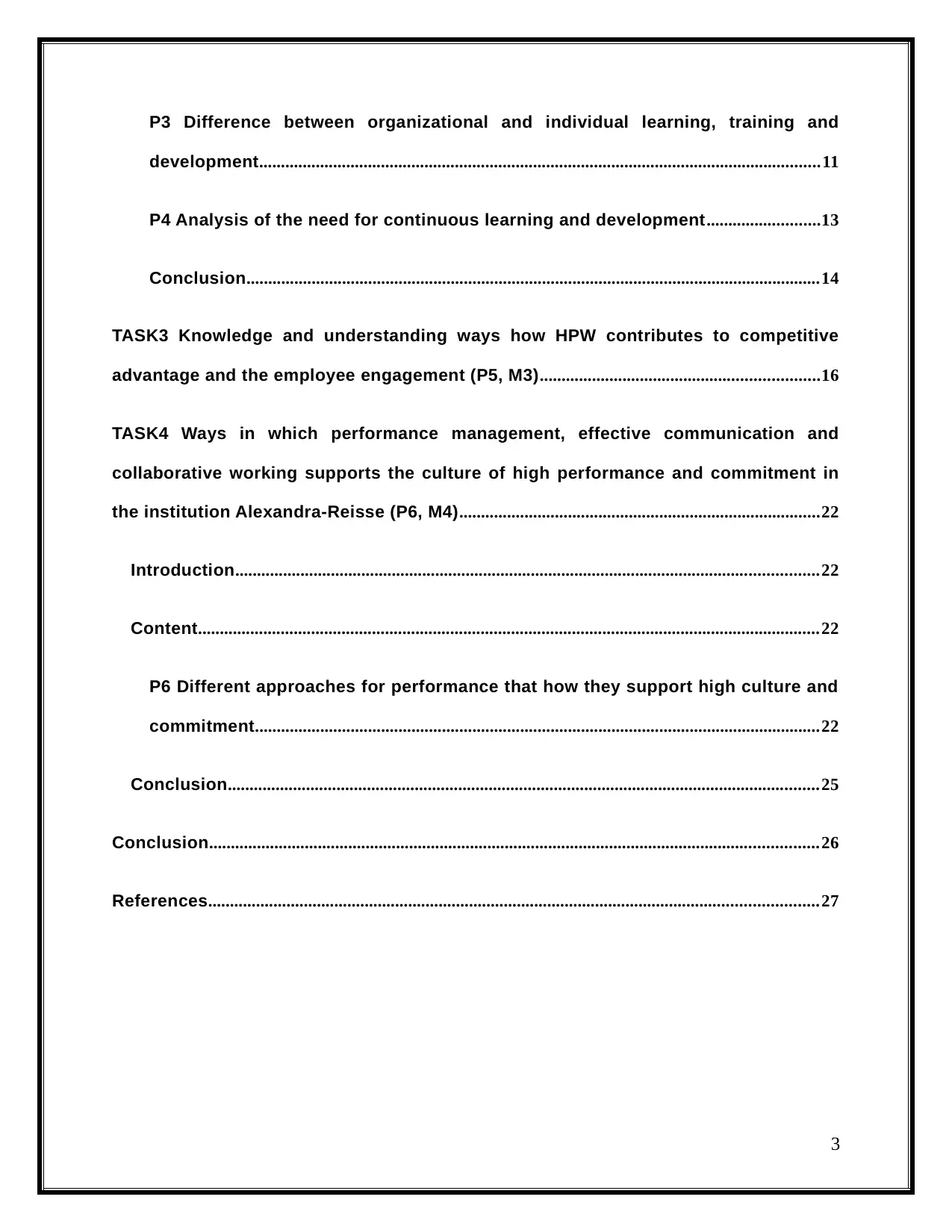
P3 Difference between organizational and individual learning, training and
development.................................................................................................................................11
P4 Analysis of the need for continuous learning and development..........................13
Conclusion....................................................................................................................................14
TASK3 Knowledge and understanding ways how HPW contributes to competitive
advantage and the employee engagement (P5, M3)................................................................16
TASK4 Ways in which performance management, effective communication and
collaborative working supports the culture of high performance and commitment in
the institution Alexandra-Reisse (P6, M4)...................................................................................22
Introduction......................................................................................................................................22
Content...............................................................................................................................................22
P6 Different approaches for performance that how they support high culture and
commitment..................................................................................................................................22
Conclusion........................................................................................................................................25
Conclusion............................................................................................................................................26
References............................................................................................................................................27
3
development.................................................................................................................................11
P4 Analysis of the need for continuous learning and development..........................13
Conclusion....................................................................................................................................14
TASK3 Knowledge and understanding ways how HPW contributes to competitive
advantage and the employee engagement (P5, M3)................................................................16
TASK4 Ways in which performance management, effective communication and
collaborative working supports the culture of high performance and commitment in
the institution Alexandra-Reisse (P6, M4)...................................................................................22
Introduction......................................................................................................................................22
Content...............................................................................................................................................22
P6 Different approaches for performance that how they support high culture and
commitment..................................................................................................................................22
Conclusion........................................................................................................................................25
Conclusion............................................................................................................................................26
References............................................................................................................................................27
3
⊘ This is a preview!⊘
Do you want full access?
Subscribe today to unlock all pages.

Trusted by 1+ million students worldwide
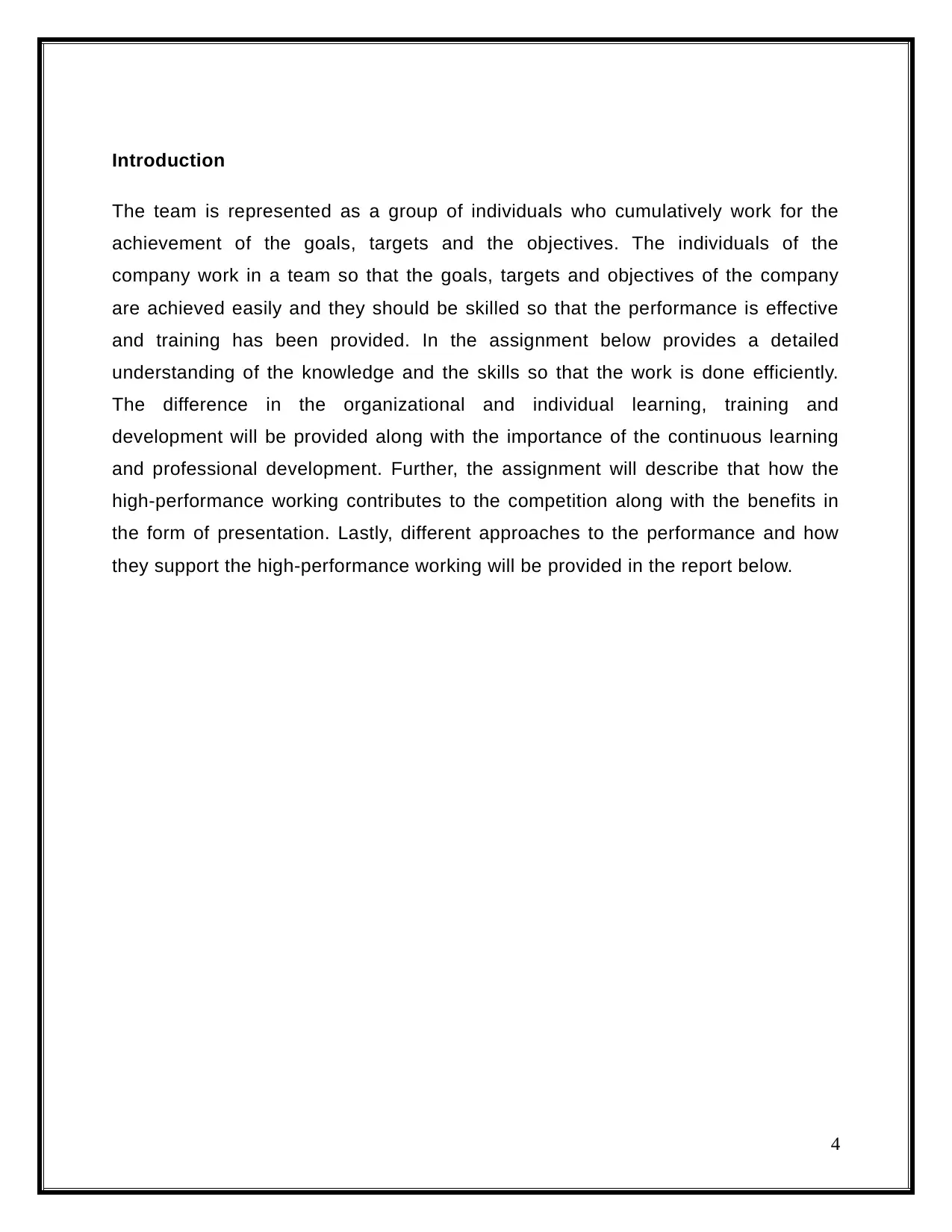
Introduction
The team is represented as a group of individuals who cumulatively work for the
achievement of the goals, targets and the objectives. The individuals of the
company work in a team so that the goals, targets and objectives of the company
are achieved easily and they should be skilled so that the performance is effective
and training has been provided. In the assignment below provides a detailed
understanding of the knowledge and the skills so that the work is done efficiently.
The difference in the organizational and individual learning, training and
development will be provided along with the importance of the continuous learning
and professional development. Further, the assignment will describe that how the
high-performance working contributes to the competition along with the benefits in
the form of presentation. Lastly, different approaches to the performance and how
they support the high-performance working will be provided in the report below.
4
The team is represented as a group of individuals who cumulatively work for the
achievement of the goals, targets and the objectives. The individuals of the
company work in a team so that the goals, targets and objectives of the company
are achieved easily and they should be skilled so that the performance is effective
and training has been provided. In the assignment below provides a detailed
understanding of the knowledge and the skills so that the work is done efficiently.
The difference in the organizational and individual learning, training and
development will be provided along with the importance of the continuous learning
and professional development. Further, the assignment will describe that how the
high-performance working contributes to the competition along with the benefits in
the form of presentation. Lastly, different approaches to the performance and how
they support the high-performance working will be provided in the report below.
4
Paraphrase This Document
Need a fresh take? Get an instant paraphrase of this document with our AI Paraphraser
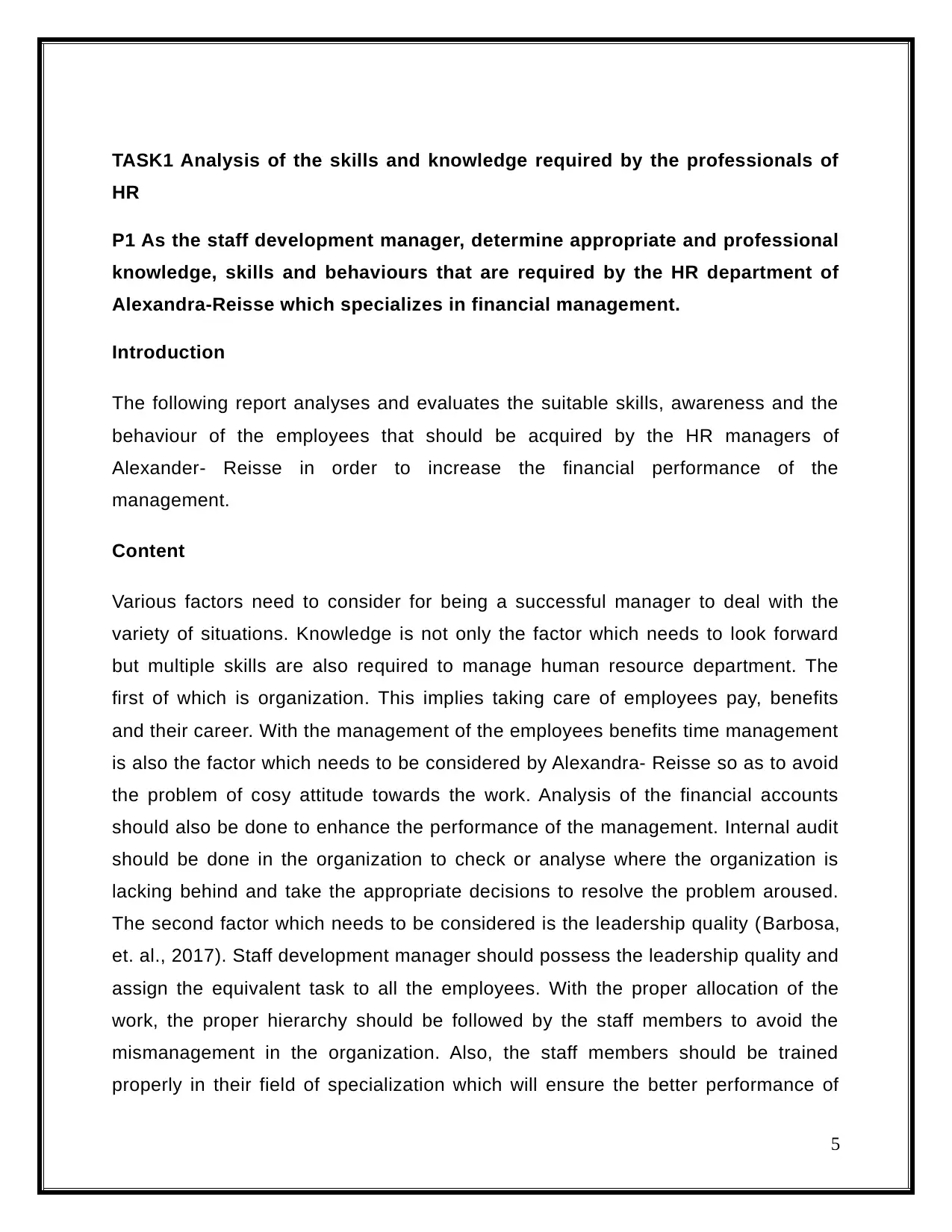
TASK1 Analysis of the skills and knowledge required by the professionals of
HR
P1 As the staff development manager, determine appropriate and professional
knowledge, skills and behaviours that are required by the HR department of
Alexandra-Reisse which specializes in financial management.
Introduction
The following report analyses and evaluates the suitable skills, awareness and the
behaviour of the employees that should be acquired by the HR managers of
Alexander- Reisse in order to increase the financial performance of the
management.
Content
Various factors need to consider for being a successful manager to deal with the
variety of situations. Knowledge is not only the factor which needs to look forward
but multiple skills are also required to manage human resource department. The
first of which is organization. This implies taking care of employees pay, benefits
and their career. With the management of the employees benefits time management
is also the factor which needs to be considered by Alexandra- Reisse so as to avoid
the problem of cosy attitude towards the work. Analysis of the financial accounts
should also be done to enhance the performance of the management. Internal audit
should be done in the organization to check or analyse where the organization is
lacking behind and take the appropriate decisions to resolve the problem aroused.
The second factor which needs to be considered is the leadership quality (Barbosa,
et. al., 2017). Staff development manager should possess the leadership quality and
assign the equivalent task to all the employees. With the proper allocation of the
work, the proper hierarchy should be followed by the staff members to avoid the
mismanagement in the organization. Also, the staff members should be trained
properly in their field of specialization which will ensure the better performance of
5
HR
P1 As the staff development manager, determine appropriate and professional
knowledge, skills and behaviours that are required by the HR department of
Alexandra-Reisse which specializes in financial management.
Introduction
The following report analyses and evaluates the suitable skills, awareness and the
behaviour of the employees that should be acquired by the HR managers of
Alexander- Reisse in order to increase the financial performance of the
management.
Content
Various factors need to consider for being a successful manager to deal with the
variety of situations. Knowledge is not only the factor which needs to look forward
but multiple skills are also required to manage human resource department. The
first of which is organization. This implies taking care of employees pay, benefits
and their career. With the management of the employees benefits time management
is also the factor which needs to be considered by Alexandra- Reisse so as to avoid
the problem of cosy attitude towards the work. Analysis of the financial accounts
should also be done to enhance the performance of the management. Internal audit
should be done in the organization to check or analyse where the organization is
lacking behind and take the appropriate decisions to resolve the problem aroused.
The second factor which needs to be considered is the leadership quality (Barbosa,
et. al., 2017). Staff development manager should possess the leadership quality and
assign the equivalent task to all the employees. With the proper allocation of the
work, the proper hierarchy should be followed by the staff members to avoid the
mismanagement in the organization. Also, the staff members should be trained
properly in their field of specialization which will ensure the better performance of
5
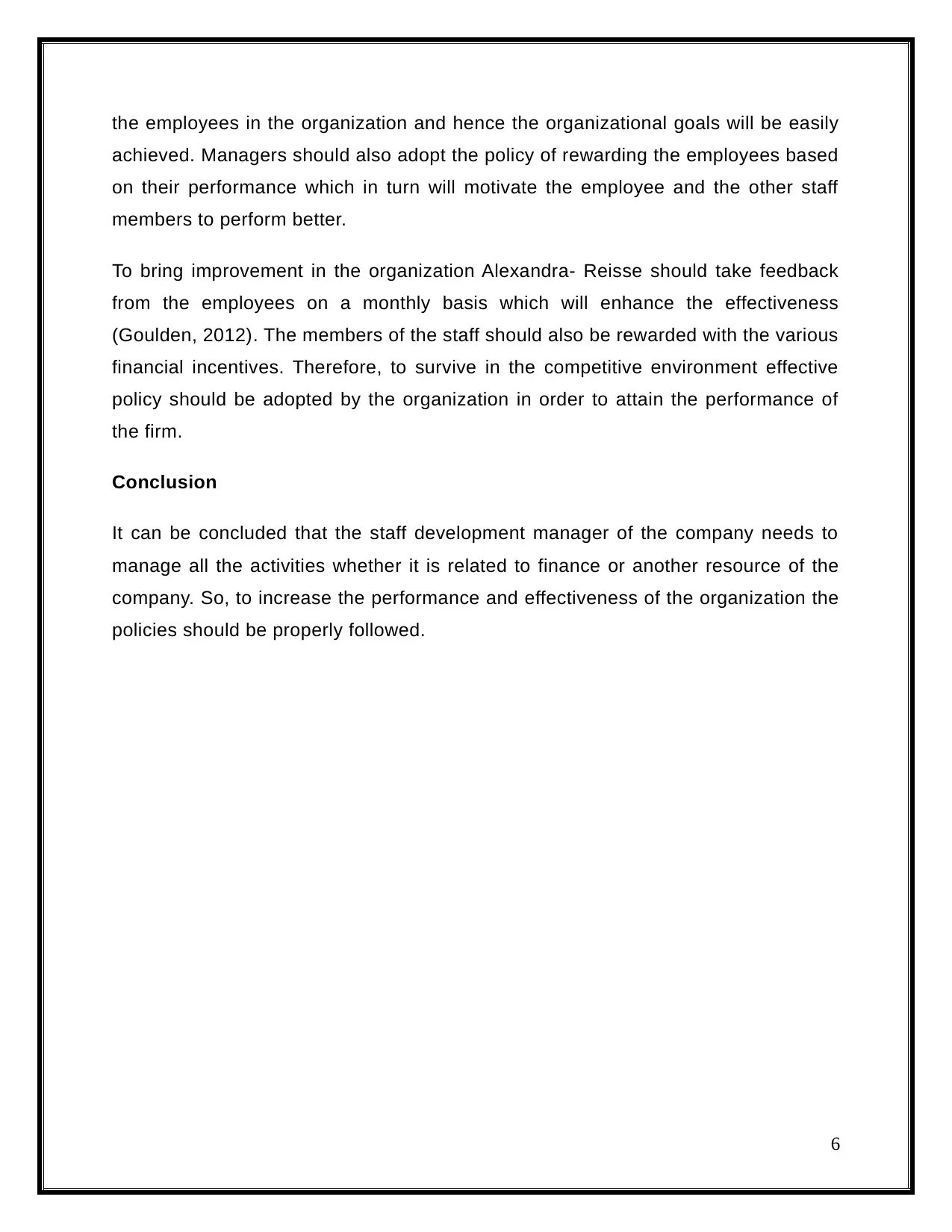
the employees in the organization and hence the organizational goals will be easily
achieved. Managers should also adopt the policy of rewarding the employees based
on their performance which in turn will motivate the employee and the other staff
members to perform better.
To bring improvement in the organization Alexandra- Reisse should take feedback
from the employees on a monthly basis which will enhance the effectiveness
(Goulden, 2012). The members of the staff should also be rewarded with the various
financial incentives. Therefore, to survive in the competitive environment effective
policy should be adopted by the organization in order to attain the performance of
the firm.
Conclusion
It can be concluded that the staff development manager of the company needs to
manage all the activities whether it is related to finance or another resource of the
company. So, to increase the performance and effectiveness of the organization the
policies should be properly followed.
6
achieved. Managers should also adopt the policy of rewarding the employees based
on their performance which in turn will motivate the employee and the other staff
members to perform better.
To bring improvement in the organization Alexandra- Reisse should take feedback
from the employees on a monthly basis which will enhance the effectiveness
(Goulden, 2012). The members of the staff should also be rewarded with the various
financial incentives. Therefore, to survive in the competitive environment effective
policy should be adopted by the organization in order to attain the performance of
the firm.
Conclusion
It can be concluded that the staff development manager of the company needs to
manage all the activities whether it is related to finance or another resource of the
company. So, to increase the performance and effectiveness of the organization the
policies should be properly followed.
6
⊘ This is a preview!⊘
Do you want full access?
Subscribe today to unlock all pages.

Trusted by 1+ million students worldwide
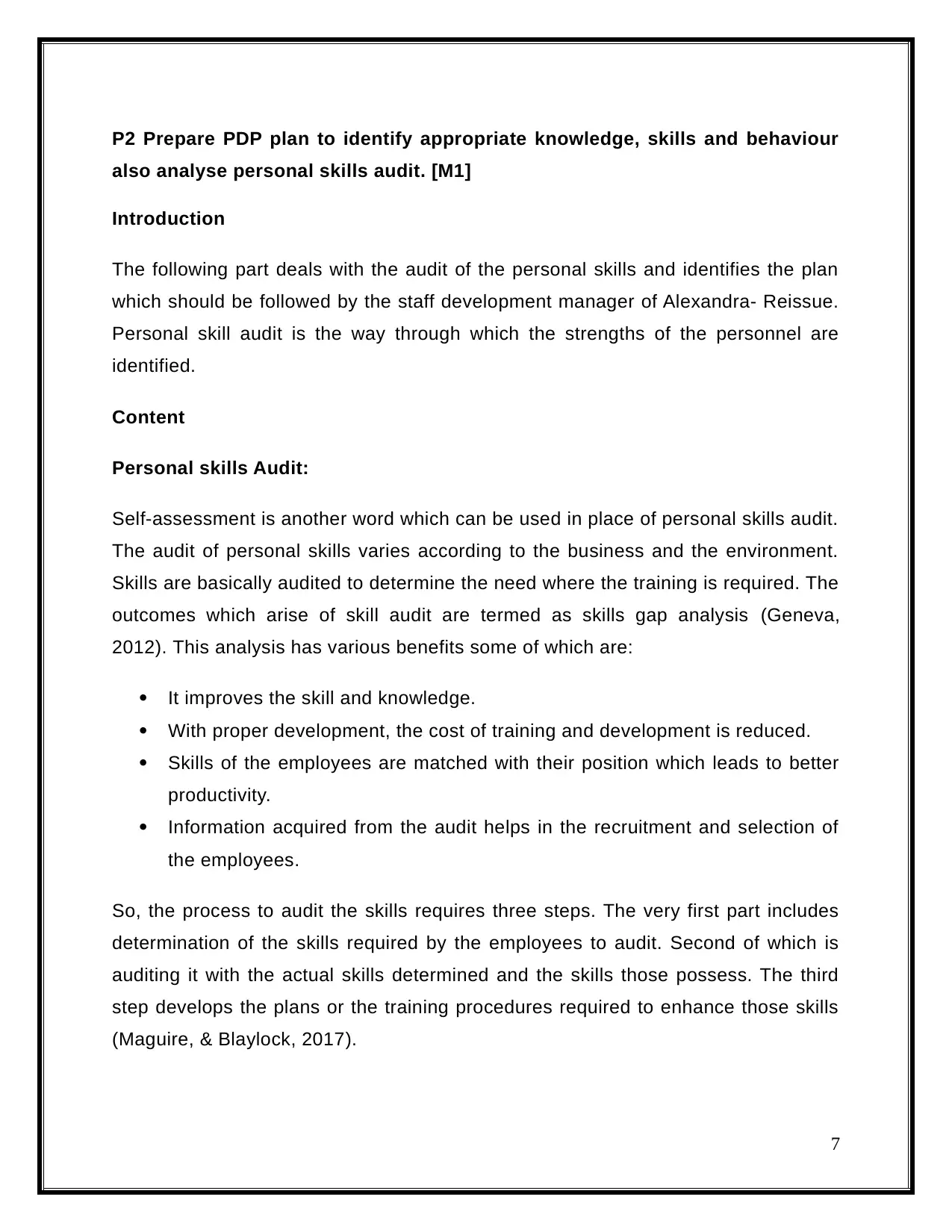
P2 Prepare PDP plan to identify appropriate knowledge, skills and behaviour
also analyse personal skills audit. [M1]
Introduction
The following part deals with the audit of the personal skills and identifies the plan
which should be followed by the staff development manager of Alexandra- Reissue.
Personal skill audit is the way through which the strengths of the personnel are
identified.
Content
Personal skills Audit:
Self-assessment is another word which can be used in place of personal skills audit.
The audit of personal skills varies according to the business and the environment.
Skills are basically audited to determine the need where the training is required. The
outcomes which arise of skill audit are termed as skills gap analysis (Geneva,
2012). This analysis has various benefits some of which are:
It improves the skill and knowledge.
With proper development, the cost of training and development is reduced.
Skills of the employees are matched with their position which leads to better
productivity.
Information acquired from the audit helps in the recruitment and selection of
the employees.
So, the process to audit the skills requires three steps. The very first part includes
determination of the skills required by the employees to audit. Second of which is
auditing it with the actual skills determined and the skills those possess. The third
step develops the plans or the training procedures required to enhance those skills
(Maguire, & Blaylock, 2017).
7
also analyse personal skills audit. [M1]
Introduction
The following part deals with the audit of the personal skills and identifies the plan
which should be followed by the staff development manager of Alexandra- Reissue.
Personal skill audit is the way through which the strengths of the personnel are
identified.
Content
Personal skills Audit:
Self-assessment is another word which can be used in place of personal skills audit.
The audit of personal skills varies according to the business and the environment.
Skills are basically audited to determine the need where the training is required. The
outcomes which arise of skill audit are termed as skills gap analysis (Geneva,
2012). This analysis has various benefits some of which are:
It improves the skill and knowledge.
With proper development, the cost of training and development is reduced.
Skills of the employees are matched with their position which leads to better
productivity.
Information acquired from the audit helps in the recruitment and selection of
the employees.
So, the process to audit the skills requires three steps. The very first part includes
determination of the skills required by the employees to audit. Second of which is
auditing it with the actual skills determined and the skills those possess. The third
step develops the plans or the training procedures required to enhance those skills
(Maguire, & Blaylock, 2017).
7
Paraphrase This Document
Need a fresh take? Get an instant paraphrase of this document with our AI Paraphraser
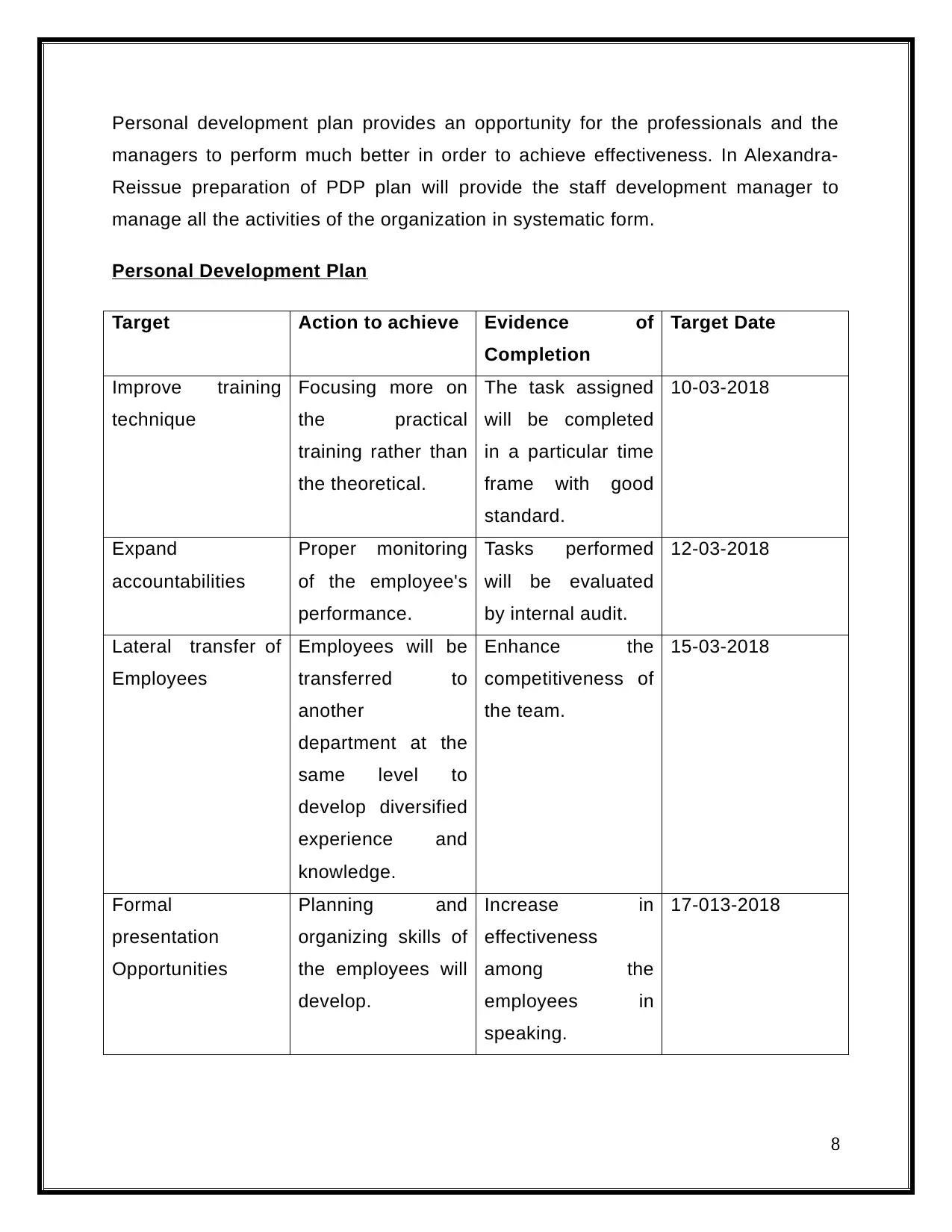
Personal development plan provides an opportunity for the professionals and the
managers to perform much better in order to achieve effectiveness. In Alexandra-
Reissue preparation of PDP plan will provide the staff development manager to
manage all the activities of the organization in systematic form.
Personal Development Plan
Target Action to achieve Evidence of
Completion
Target Date
Improve training
technique
Focusing more on
the practical
training rather than
the theoretical.
The task assigned
will be completed
in a particular time
frame with good
standard.
10-03-2018
Expand
accountabilities
Proper monitoring
of the employee's
performance.
Tasks performed
will be evaluated
by internal audit.
12-03-2018
Lateral transfer of
Employees
Employees will be
transferred to
another
department at the
same level to
develop diversified
experience and
knowledge.
Enhance the
competitiveness of
the team.
15-03-2018
Formal
presentation
Opportunities
Planning and
organizing skills of
the employees will
develop.
Increase in
effectiveness
among the
employees in
speaking.
17-013-2018
8
managers to perform much better in order to achieve effectiveness. In Alexandra-
Reissue preparation of PDP plan will provide the staff development manager to
manage all the activities of the organization in systematic form.
Personal Development Plan
Target Action to achieve Evidence of
Completion
Target Date
Improve training
technique
Focusing more on
the practical
training rather than
the theoretical.
The task assigned
will be completed
in a particular time
frame with good
standard.
10-03-2018
Expand
accountabilities
Proper monitoring
of the employee's
performance.
Tasks performed
will be evaluated
by internal audit.
12-03-2018
Lateral transfer of
Employees
Employees will be
transferred to
another
department at the
same level to
develop diversified
experience and
knowledge.
Enhance the
competitiveness of
the team.
15-03-2018
Formal
presentation
Opportunities
Planning and
organizing skills of
the employees will
develop.
Increase in
effectiveness
among the
employees in
speaking.
17-013-2018
8
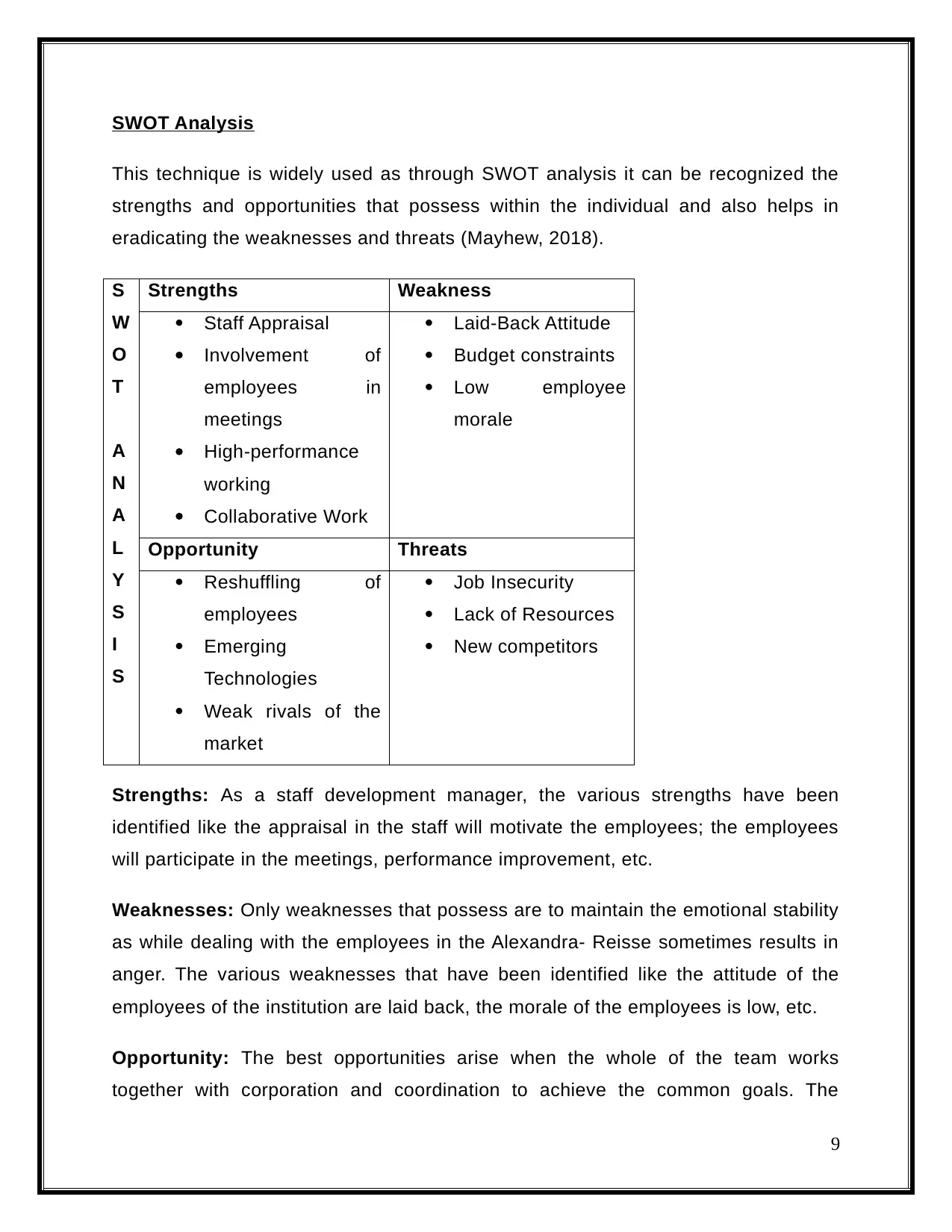
SWOT Analysis
This technique is widely used as through SWOT analysis it can be recognized the
strengths and opportunities that possess within the individual and also helps in
eradicating the weaknesses and threats (Mayhew, 2018).
S
W
O
T
A
N
A
L
Y
S
I
S
Strengths Weakness
Staff Appraisal
Involvement of
employees in
meetings
High-performance
working
Collaborative Work
Laid-Back Attitude
Budget constraints
Low employee
morale
Opportunity Threats
Reshuffling of
employees
Emerging
Technologies
Weak rivals of the
market
Job Insecurity
Lack of Resources
New competitors
Strengths: As a staff development manager, the various strengths have been
identified like the appraisal in the staff will motivate the employees; the employees
will participate in the meetings, performance improvement, etc.
Weaknesses: Only weaknesses that possess are to maintain the emotional stability
as while dealing with the employees in the Alexandra- Reisse sometimes results in
anger. The various weaknesses that have been identified like the attitude of the
employees of the institution are laid back, the morale of the employees is low, etc.
Opportunity: The best opportunities arise when the whole of the team works
together with corporation and coordination to achieve the common goals. The
9
This technique is widely used as through SWOT analysis it can be recognized the
strengths and opportunities that possess within the individual and also helps in
eradicating the weaknesses and threats (Mayhew, 2018).
S
W
O
T
A
N
A
L
Y
S
I
S
Strengths Weakness
Staff Appraisal
Involvement of
employees in
meetings
High-performance
working
Collaborative Work
Laid-Back Attitude
Budget constraints
Low employee
morale
Opportunity Threats
Reshuffling of
employees
Emerging
Technologies
Weak rivals of the
market
Job Insecurity
Lack of Resources
New competitors
Strengths: As a staff development manager, the various strengths have been
identified like the appraisal in the staff will motivate the employees; the employees
will participate in the meetings, performance improvement, etc.
Weaknesses: Only weaknesses that possess are to maintain the emotional stability
as while dealing with the employees in the Alexandra- Reisse sometimes results in
anger. The various weaknesses that have been identified like the attitude of the
employees of the institution are laid back, the morale of the employees is low, etc.
Opportunity: The best opportunities arise when the whole of the team works
together with corporation and coordination to achieve the common goals. The
9
⊘ This is a preview!⊘
Do you want full access?
Subscribe today to unlock all pages.

Trusted by 1+ million students worldwide
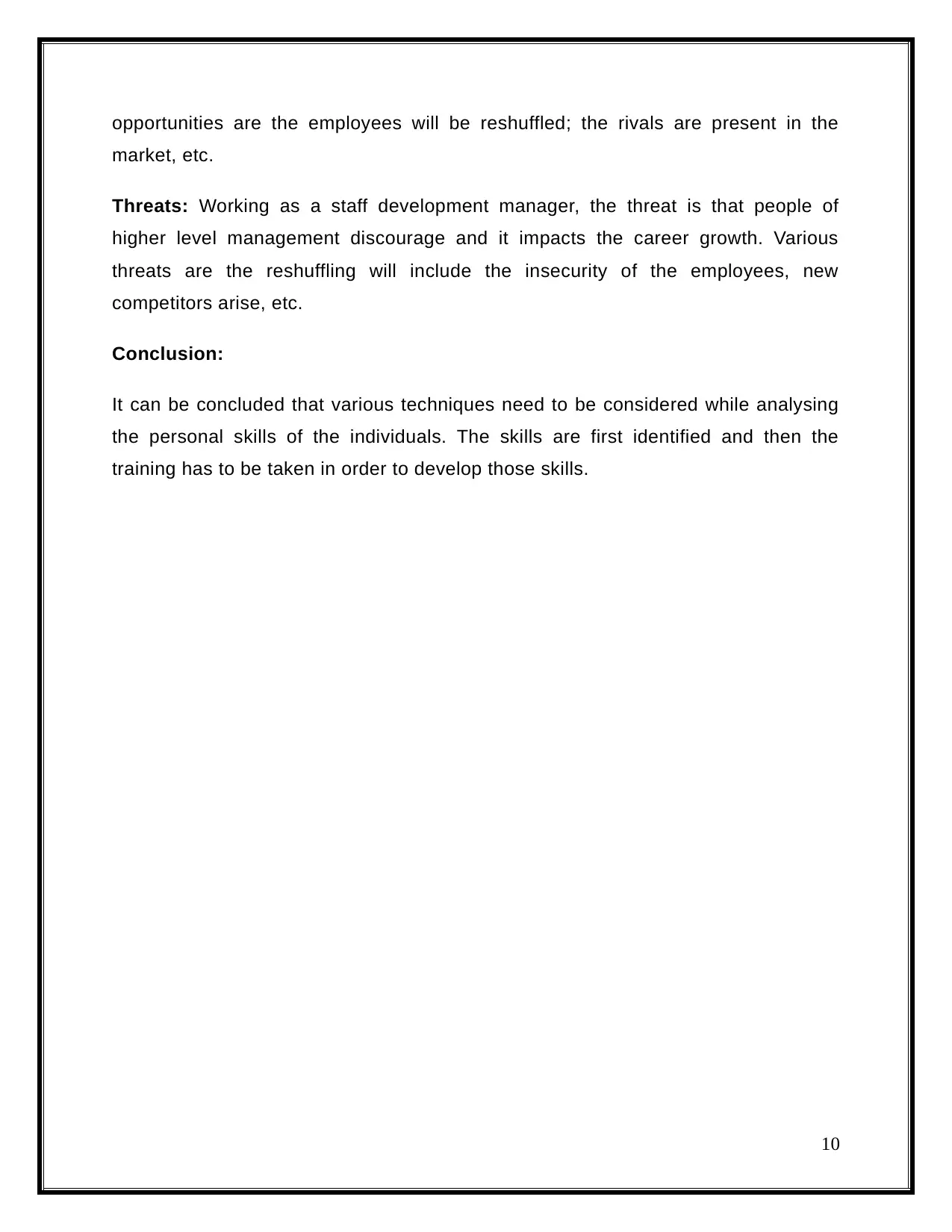
opportunities are the employees will be reshuffled; the rivals are present in the
market, etc.
Threats: Working as a staff development manager, the threat is that people of
higher level management discourage and it impacts the career growth. Various
threats are the reshuffling will include the insecurity of the employees, new
competitors arise, etc.
Conclusion:
It can be concluded that various techniques need to be considered while analysing
the personal skills of the individuals. The skills are first identified and then the
training has to be taken in order to develop those skills.
10
market, etc.
Threats: Working as a staff development manager, the threat is that people of
higher level management discourage and it impacts the career growth. Various
threats are the reshuffling will include the insecurity of the employees, new
competitors arise, etc.
Conclusion:
It can be concluded that various techniques need to be considered while analysing
the personal skills of the individuals. The skills are first identified and then the
training has to be taken in order to develop those skills.
10
Paraphrase This Document
Need a fresh take? Get an instant paraphrase of this document with our AI Paraphraser
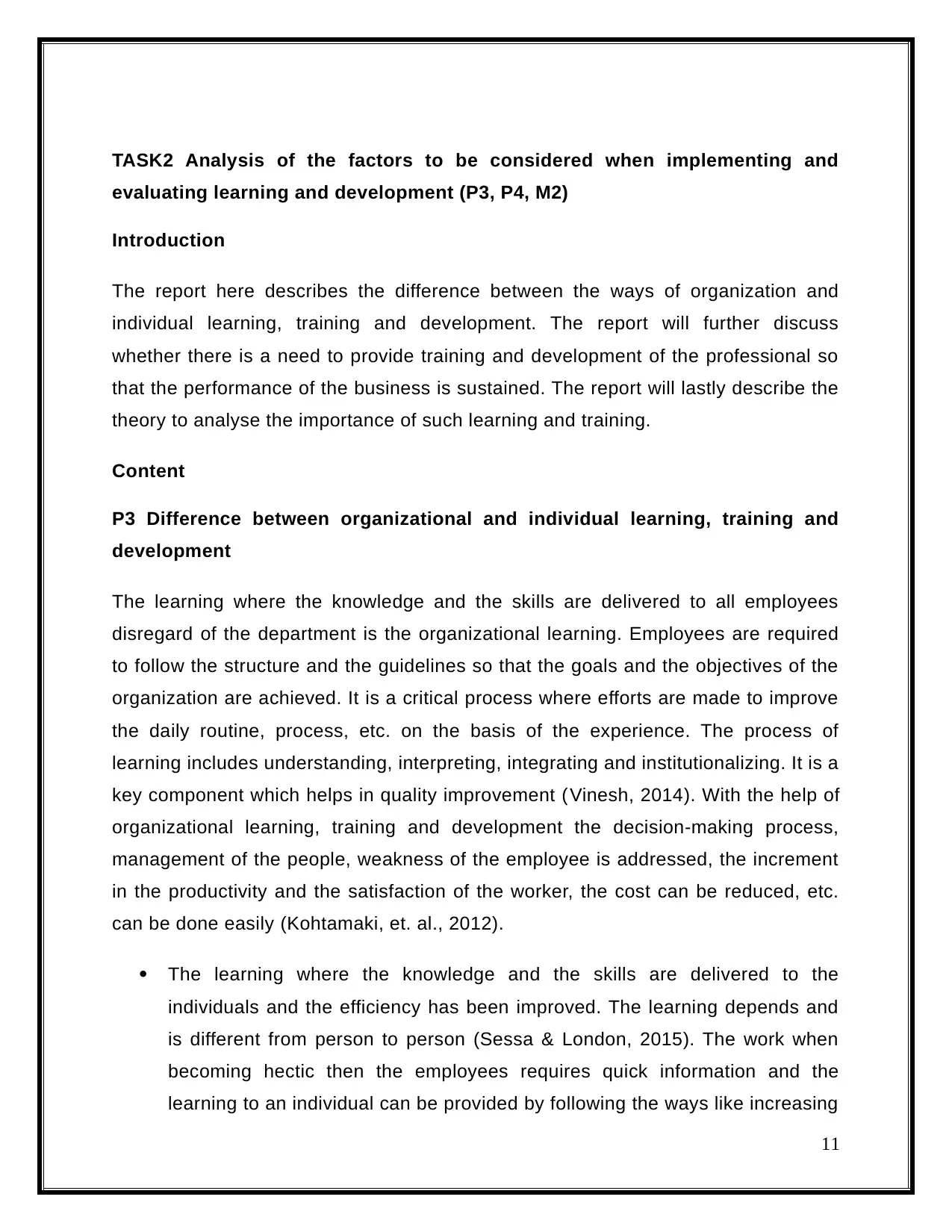
TASK2 Analysis of the factors to be considered when implementing and
evaluating learning and development (P3, P4, M2)
Introduction
The report here describes the difference between the ways of organization and
individual learning, training and development. The report will further discuss
whether there is a need to provide training and development of the professional so
that the performance of the business is sustained. The report will lastly describe the
theory to analyse the importance of such learning and training.
Content
P3 Difference between organizational and individual learning, training and
development
The learning where the knowledge and the skills are delivered to all employees
disregard of the department is the organizational learning. Employees are required
to follow the structure and the guidelines so that the goals and the objectives of the
organization are achieved. It is a critical process where efforts are made to improve
the daily routine, process, etc. on the basis of the experience. The process of
learning includes understanding, interpreting, integrating and institutionalizing. It is a
key component which helps in quality improvement (Vinesh, 2014). With the help of
organizational learning, training and development the decision-making process,
management of the people, weakness of the employee is addressed, the increment
in the productivity and the satisfaction of the worker, the cost can be reduced, etc.
can be done easily (Kohtamaki, et. al., 2012).
The learning where the knowledge and the skills are delivered to the
individuals and the efficiency has been improved. The learning depends and
is different from person to person (Sessa & London, 2015). The work when
becoming hectic then the employees requires quick information and the
learning to an individual can be provided by following the ways like increasing
11
evaluating learning and development (P3, P4, M2)
Introduction
The report here describes the difference between the ways of organization and
individual learning, training and development. The report will further discuss
whether there is a need to provide training and development of the professional so
that the performance of the business is sustained. The report will lastly describe the
theory to analyse the importance of such learning and training.
Content
P3 Difference between organizational and individual learning, training and
development
The learning where the knowledge and the skills are delivered to all employees
disregard of the department is the organizational learning. Employees are required
to follow the structure and the guidelines so that the goals and the objectives of the
organization are achieved. It is a critical process where efforts are made to improve
the daily routine, process, etc. on the basis of the experience. The process of
learning includes understanding, interpreting, integrating and institutionalizing. It is a
key component which helps in quality improvement (Vinesh, 2014). With the help of
organizational learning, training and development the decision-making process,
management of the people, weakness of the employee is addressed, the increment
in the productivity and the satisfaction of the worker, the cost can be reduced, etc.
can be done easily (Kohtamaki, et. al., 2012).
The learning where the knowledge and the skills are delivered to the
individuals and the efficiency has been improved. The learning depends and
is different from person to person (Sessa & London, 2015). The work when
becoming hectic then the employees requires quick information and the
learning to an individual can be provided by following the ways like increasing
11
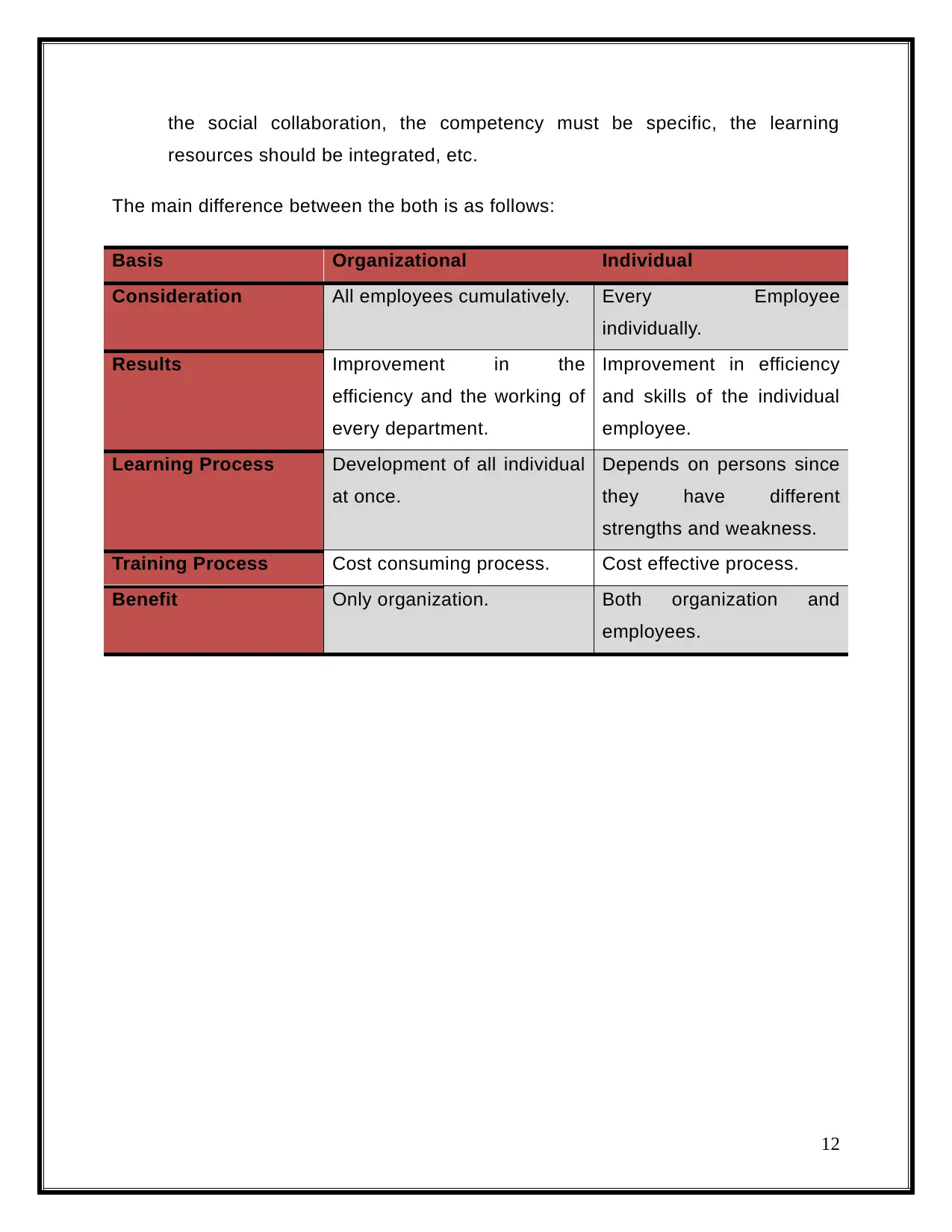
the social collaboration, the competency must be specific, the learning
resources should be integrated, etc.
The main difference between the both is as follows:
Basis Organizational Individual
Consideration All employees cumulatively. Every Employee
individually.
Results Improvement in the
efficiency and the working of
every department.
Improvement in efficiency
and skills of the individual
employee.
Learning Process Development of all individual
at once.
Depends on persons since
they have different
strengths and weakness.
Training Process Cost consuming process. Cost effective process.
Benefit Only organization. Both organization and
employees.
12
resources should be integrated, etc.
The main difference between the both is as follows:
Basis Organizational Individual
Consideration All employees cumulatively. Every Employee
individually.
Results Improvement in the
efficiency and the working of
every department.
Improvement in efficiency
and skills of the individual
employee.
Learning Process Development of all individual
at once.
Depends on persons since
they have different
strengths and weakness.
Training Process Cost consuming process. Cost effective process.
Benefit Only organization. Both organization and
employees.
12
⊘ This is a preview!⊘
Do you want full access?
Subscribe today to unlock all pages.

Trusted by 1+ million students worldwide
1 out of 28
Related Documents
Your All-in-One AI-Powered Toolkit for Academic Success.
+13062052269
info@desklib.com
Available 24*7 on WhatsApp / Email
![[object Object]](/_next/static/media/star-bottom.7253800d.svg)
Unlock your academic potential
Copyright © 2020–2025 A2Z Services. All Rights Reserved. Developed and managed by ZUCOL.




